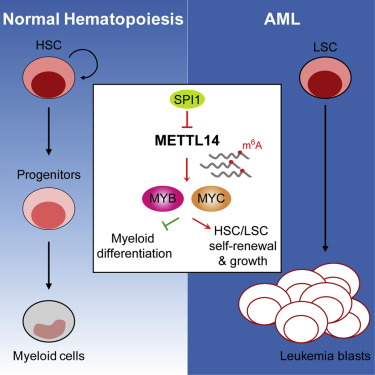当前位置:
X-MOL 学术
›
Cell Stem Cell
›
论文详情
Our official English website, www.x-mol.net, welcomes your
feedback! (Note: you will need to create a separate account there.)
METTL14 Inhibits Hematopoietic Stem/Progenitor Differentiation and Promotes Leukemogenesis via mRNA m6A Modification.
Cell Stem Cell ( IF 19.8 ) Pub Date : 2018-Feb-01 , DOI: 10.1016/j.stem.2017.11.016 Hengyou Weng 1 , Huilin Huang 1 , Huizhe Wu 2 , Xi Qin 1 , Boxuan Simen Zhao 3 , Lei Dong 1 , Hailing Shi 3 , Jennifer Skibbe 1 , Chao Shen 1 , Chao Hu 4 , Yue Sheng 5 , Yungui Wang 4 , Mark Wunderlich 6 , Bin Zhang 7 , Louis C Dore 3 , Rui Su 1 , Xiaolan Deng 2 , Kyle Ferchen 1 , Chenying Li 4 , Miao Sun 8 , Zhike Lu 3 , Xi Jiang 1 , Guido Marcucci 7 , James C Mulloy 6 , Jianhua Yang 9 , Zhijian Qian 5 , Minjie Wei 10 , Chuan He 3 , Jianjun Chen 1
Cell Stem Cell ( IF 19.8 ) Pub Date : 2018-Feb-01 , DOI: 10.1016/j.stem.2017.11.016 Hengyou Weng 1 , Huilin Huang 1 , Huizhe Wu 2 , Xi Qin 1 , Boxuan Simen Zhao 3 , Lei Dong 1 , Hailing Shi 3 , Jennifer Skibbe 1 , Chao Shen 1 , Chao Hu 4 , Yue Sheng 5 , Yungui Wang 4 , Mark Wunderlich 6 , Bin Zhang 7 , Louis C Dore 3 , Rui Su 1 , Xiaolan Deng 2 , Kyle Ferchen 1 , Chenying Li 4 , Miao Sun 8 , Zhike Lu 3 , Xi Jiang 1 , Guido Marcucci 7 , James C Mulloy 6 , Jianhua Yang 9 , Zhijian Qian 5 , Minjie Wei 10 , Chuan He 3 , Jianjun Chen 1
Affiliation

|
N6-methyladenosine (m6A), the most prevalent internal modification in eukaryotic messenger RNAs (mRNAs), plays critical roles in many bioprocesses. However, its functions in normal and malignant hematopoiesis remain elusive. Here, we report that METTL14, a key component of the m6A methyltransferase complex, is highly expressed in normal hematopoietic stem/progenitor cells (HSPCs) and acute myeloid leukemia (AML) cells carrying t(11q23), t(15;17), or t(8;21) and is downregulated during myeloid differentiation. Silencing of METTL14 promotes terminal myeloid differentiation of normal HSPCs and AML cells and inhibits AML cell survival/proliferation. METTL14 is required for development and maintenance of AML and self-renewal of leukemia stem/initiation cells (LSCs/LICs). Mechanistically, METTL14 exerts its oncogenic role by regulating its mRNA targets (e.g., MYB and MYC) through m6A modification, while the protein itself is negatively regulated by SPI1. Collectively, our results reveal the SPI1-METTL14-MYB/MYC signaling axis in myelopoiesis and leukemogenesis and highlight the critical roles of METTL14 and m6A modification in normal and malignant hematopoiesis.
中文翻译:

METTL14 通过 mRNA m6A 修饰抑制造血干/祖细胞分化并促进白血病发生。
N 6 -甲基腺苷 (m 6 A) 是真核生物信使 RNA (mRNA) 中最常见的内部修饰,在许多生物过程中发挥着关键作用。然而,其在正常和恶性造血中的功能仍然难以捉摸。在此,我们报道 METTL14 是 m 6 A 甲基转移酶复合物的关键成分,在携带 t(11q23)、t(15;17) 的正常造血干/祖细胞 (HSPC) 和急性髓系白血病 (AML) 细胞中高表达。 ) 或 t(8;21) 并且在骨髓分化过程中下调。 METTL14 的沉默可促进正常 HSPC 和 AML 细胞的终末骨髓分化,并抑制 AML 细胞的存活/增殖。 METTL14 是 AML 的发育和维持以及白血病干细胞/起始细胞 (LSC/LIC) 自我更新所必需的。从机制上讲,METTL14通过m 6 A修饰调节其mRNA靶标(例如MYB和MYC)来发挥其致癌作用,而蛋白质本身则受到SPI1的负向调节。总的来说,我们的结果揭示了 SPI1-METTL14-MYB/MYC 信号轴在骨髓生成和白血病发生中的作用,并强调了 METTL14 和 m 6 A 修饰在正常和恶性造血中的关键作用。
更新日期:2017-12-31
中文翻译:

METTL14 通过 mRNA m6A 修饰抑制造血干/祖细胞分化并促进白血病发生。
N 6 -甲基腺苷 (m 6 A) 是真核生物信使 RNA (mRNA) 中最常见的内部修饰,在许多生物过程中发挥着关键作用。然而,其在正常和恶性造血中的功能仍然难以捉摸。在此,我们报道 METTL14 是 m 6 A 甲基转移酶复合物的关键成分,在携带 t(11q23)、t(15;17) 的正常造血干/祖细胞 (HSPC) 和急性髓系白血病 (AML) 细胞中高表达。 ) 或 t(8;21) 并且在骨髓分化过程中下调。 METTL14 的沉默可促进正常 HSPC 和 AML 细胞的终末骨髓分化,并抑制 AML 细胞的存活/增殖。 METTL14 是 AML 的发育和维持以及白血病干细胞/起始细胞 (LSC/LIC) 自我更新所必需的。从机制上讲,METTL14通过m 6 A修饰调节其mRNA靶标(例如MYB和MYC)来发挥其致癌作用,而蛋白质本身则受到SPI1的负向调节。总的来说,我们的结果揭示了 SPI1-METTL14-MYB/MYC 信号轴在骨髓生成和白血病发生中的作用,并强调了 METTL14 和 m 6 A 修饰在正常和恶性造血中的关键作用。











































 京公网安备 11010802027423号
京公网安备 11010802027423号